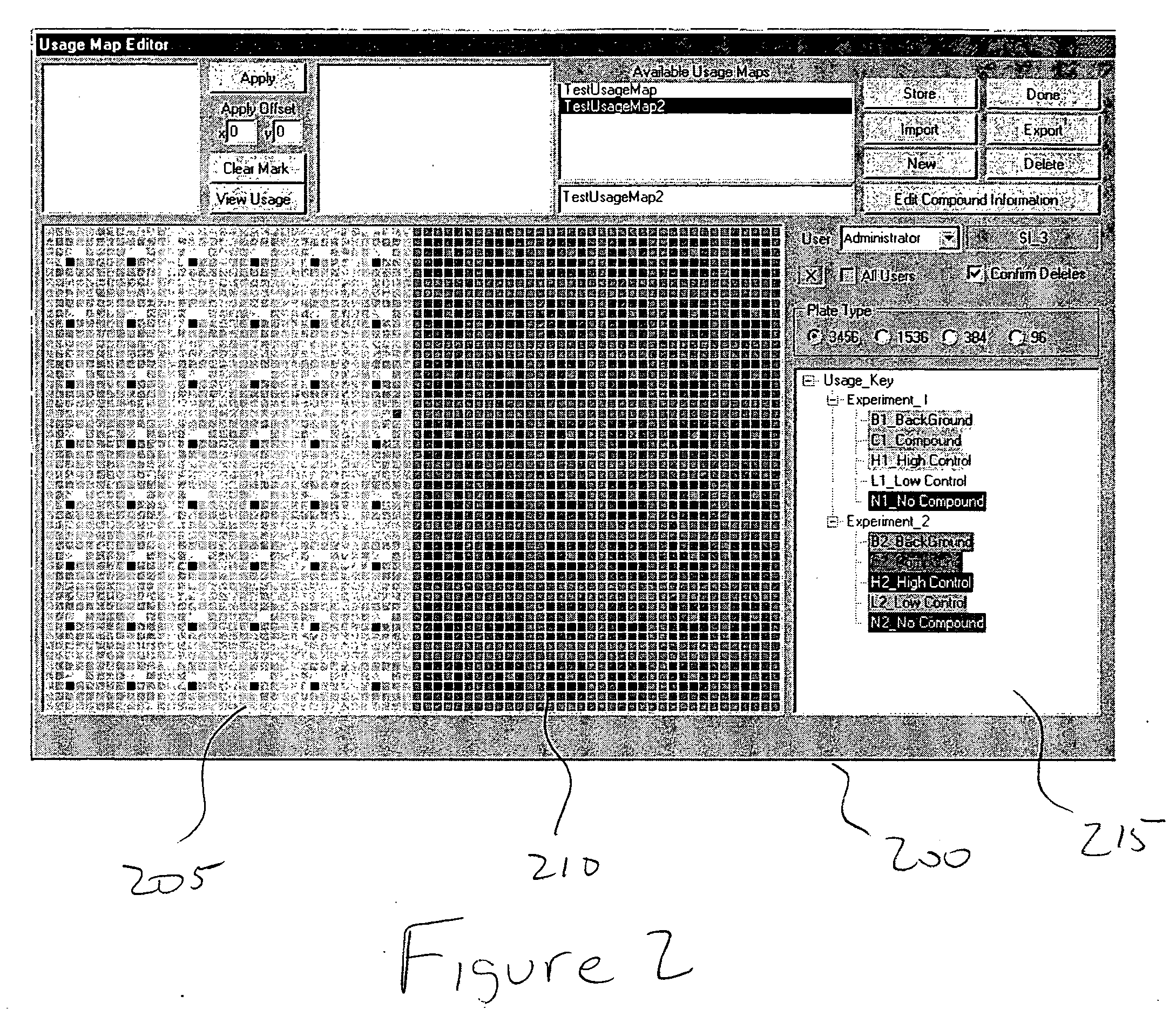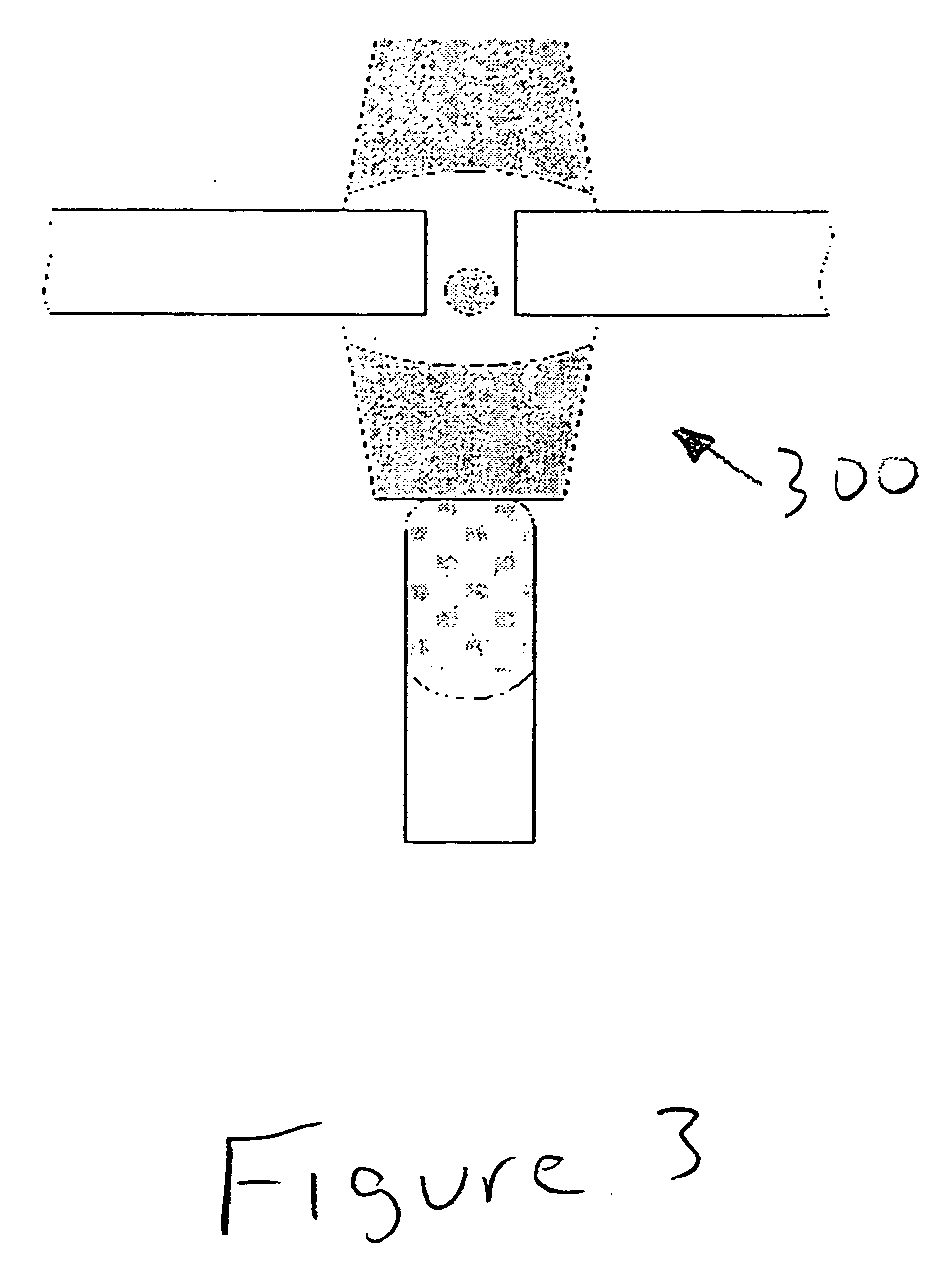[0111] Applications of the invention: The invention is suitable for the parallel staging of a wide variety of assays in miniaturized format. These assays include, but are not limited to, those that provide spectrometric readouts. Assays may be designed to measure
biochemical reactions, such as the inhibition or potentiation of enzymatic activity, such as
cytochrome P-450, a major detoxifying
enzyme of liver (see U.S. Pat. No. 6,514,687). Assays may also incorporate the various manipulations required for
molecular biology, including, but not limited to reverse transcription,
polymerase chain reaction,
nucleic acid hybridization,
restriction enzyme digestion and fragment analysis,
nucleic acid separation by electrophoretic mobility, fragment
ligation and vector construction,
nucleic acid sequencing, or analysis of
gene expression. Because many individual assays can be staged on single, high-density
multiwell plate, the
system described enables performance of the same types of
gene expression analysis presently performed with nucleic acid microarrays. High-
throughput microarray analysis is available commercially from GeneXP Biosciences. One
advantage of the present invention is that distinct nucleic sequences can be confined to individual miniaturized wells. Thus there is no need to confine the distinct sequences to discrete locations on a single substrate in which all locations are contacted by a common
liquid medium, as is the case with microarrays. This eliminates the need to spot the same
nucleic acid sequence at multiple different locations on the array, which is required to ensure that the signal arising from a given spot is not due to
contamination by sequences from neighboring locations. In the
multiwell plate, each distinct sequence
pool is physically isolated from its neighbors, and never comes into common fluid contact, a major source of cross-
contamination of microarrays constructed with spots.
[0112] The flexibility afforded by the present invention in conducting
microarray assays in high-density multiwell plates also extends to
kinetic analysis of
gene expression including the simultaneous monitoring of the expression of multiple genes. Each well in a high-density
multiwell plate provides a discrete sample container for up to ˜10,000 cells. Since only very small volumes, e.g., 10 nL, of
cell concentrate modulators need to be added to a well in order to activate a particular physiological response in cells, such as triggering of gene expression control elements, all cells in a well are synchronized in their response to the modulator. A
kinetic analysis of the expression of multiple genes could thus be performed by using a block of multiple wells all containing essentially the same staged assay. At different times following the
initiation of the response to the modulator, the contents of a column of wells could be processed, such as by reverse transcription-
polymerase chain reaction or base labeling with
fluorophore or other
processing reactions, for counting the number of specific message transcripts. In this design, each well in a column would be processed for the transcripts resulting from the expression of a different gene. Each column in the block would comprise a time point at which the expression levels of the target genes would be measured. The contents of these wells would be transferred to a second high-density multiwell plate in which the transcript counting would be performed, such as by hybridization to sequences of the target genes under analysis using
fluorophore displacement dequenching or other techniques known to those skilled in the art. The result would be a kinetic profile of multiple gene expression in which the columns of wells would represent the
time course of gene expression and the rows in each column would track a specific gene. Since this assay would involve only routine microfluidic handling and spectrometric measurement, this type of analysis would be easily performed using the present invention.
[0113] Analysis of multiple gene expression time courses opens the avenue to the design of new assays in
chemical compound screening for discovery of new therapeutics or other uses of high-
throughput biological assays. Among the key targets of interest in
drug discovery are
signal transduction pathways in cells that are activated or inhibited by the binding of ligands such as neurotransmitters, hormones, cytokines, or other
extracellular modulators to membrane receptors. These receptors in turn activate of inhibit the activities of a wide variety of
intracellular modulators of
biochemical activity such as heterotrimeric G proteins, kinases, proteins that control the expression of genes, or other modulatory factors. A critical need for application of the
sequencing data gathered by the Human
Genome Project is the functional linkage of gene products and control elements into biochemical circuits. That is, it is now necessary to discover and organize the relationships between the different gene products into functional pathways. Because the present invention incorporates routine assay staging in high-density multiwell plates, it is uniquely suited to this challenge by monitoring the expression of a large number of genes over time. This will enable changes in the entire physiological state of a
cell to be measured in response to a biological modulator or to a potential therapeutic agent.
[0114] The present invention is useful for new methods for elucidating the function of gene products, such as the generation and analysis of cells in which the product of a
single gene or multiple genes are knocked out by
RNA interference.
RNA interference is naturally occurring process in which a double-stranded
small RNA 19 to 23 base pairs in length that contains sequence complementary on its
sense strand to the 5′ end of a naturally expressed
messenger RNA will cause the degradation of that mRNA. Thus, the presence of the interfering
RNA will effectively knock out a gene's product. Synthesized small interfering RNAs (siRNA) have become a new technology for understanding the function of individual genes, and for understanding the functional interactions between gene products comprising biochemical pathways in cells. The present invention provides a useful system for staging siRNA knockout assays particularly complex assays in which multiple genes are targeted in each cell.
[0115] For example, a standard assay developed for the present system utilizes control of expression of a gene for the bacterial
enzyme β-lactamase. This gene is inserted in a vector downstream from a gene expression control element such as
CREB, NFκB,
NFAT or other regulatory element. This vector is then used to transfect a cell line in which the activity of a
signal transduction pathway, which either endogenously occurs or that has been constructed by
transfection with other vectors, results in the activation of that genetic control element. Thus, when the
signal transduction pathway is activated, the reporter β-lactamase is expressed, which can be detected by its cleavage of the
fluorescence resonance energy transfer probe CCF4. Example signal transduction pathways include those regulated by such cell surface receptors such as the muscarinic
cholinergic receptor M3, the PPARγ
receptor, IFN or other
cytokine receptors, or many others.
Cell lines constructed to provide a β-lactamase readout of a signal transduction pathway are termed “biosensors”.
[0116] A
gene knockout experiment in the present invention using siRNA would test the extent to which the targeted gene's product is involved in the signal transduction pathway. Such involvement could be weak, due to its presence in a
peripheral part of the pathway, or strong due to it being a direct link between the
cell surface receptor and other elements in the main pathway. Because the high-density multiwell plate enables staging a large number of assays on a single platform, a large number of different experiments could be conducted simultaneously using the present invention. For example, the siRNA for the
target gene would be synthesized and then added to a large number of wells in a plate using acoustic dispensing. Then a wide variety of different cellular biosensors, each constructed to provide a β-lactamase expression readout of a different signal transduction or
metabolic pathway, could be added to different wells of the plate using the solenoid-metered dispensers, and the siRNA introduced into the cells by
electroporation (Gentronics Biomedical), cationic lipid,
calcium shock, or other means applied to the appropriate wells. These different assays could be staged all at once on the same plate by adding the different modulators or activators of the signal transduction pathways only to the appropriate wells containing the cells constructed to provide readouts of those pathways. The wells would be coded according to the plate usage map, and the involvement of the targeted gene could be determined from whether the siRNA exerted any effect on the normal readout of each assay. Due to the large number of wells, all positive and negative controls, including those using scrambled RNA sequences to disrupt the
RNA interference, would be present on the same assay platform, so that the siRNA effect on each signal transduction pathway would be unambiguous. Determining the extent of mRNA inhibition produced by the siRNA could also be determined after the assay using the molecular biological protocols inherent to the present invention. In addition, the role of a particular product could be measured by characterizing the effects of a
library of chemical compounds on the signal transduction pathway in the presence and absence of the targeted
gene product. This would provide information as to the true molecular target of a
chemical compound under development as a therapeutic.
 Login to View More
Login to View More 


